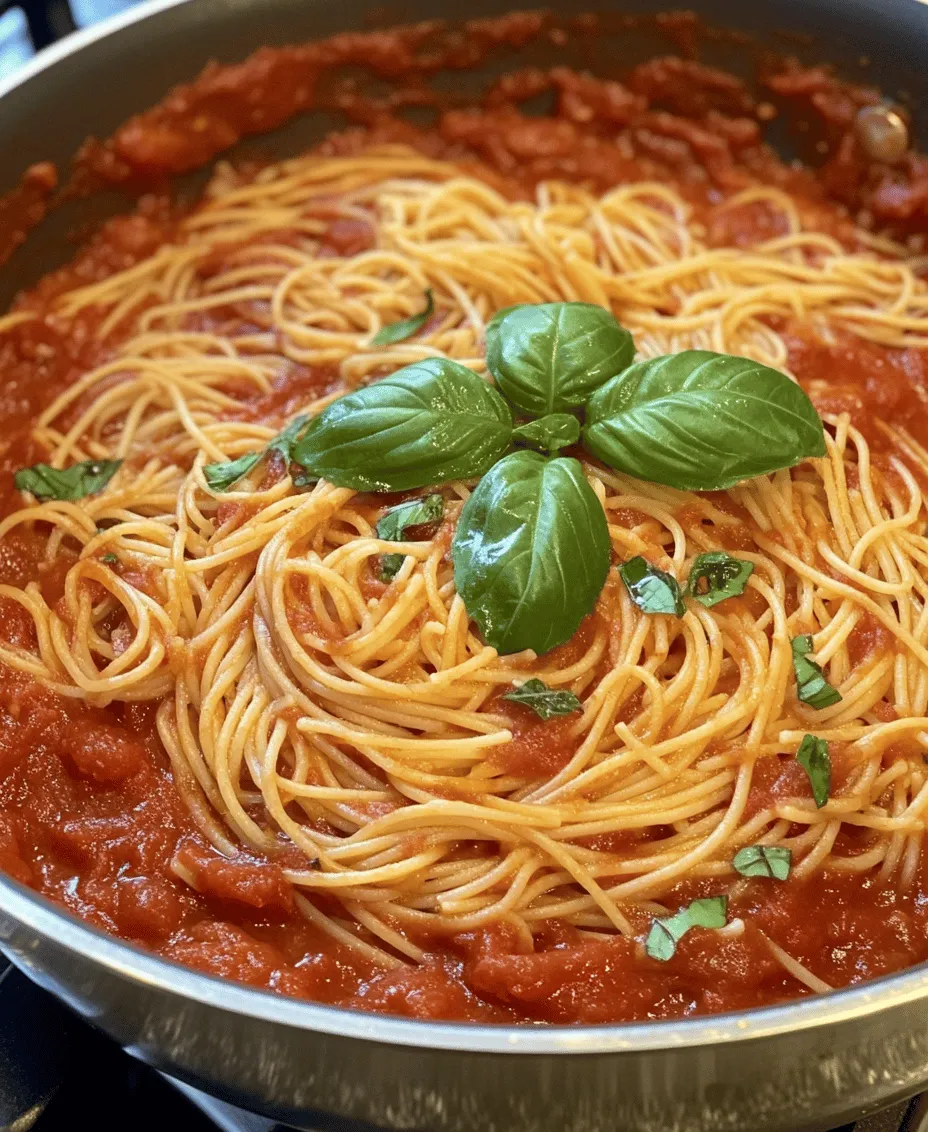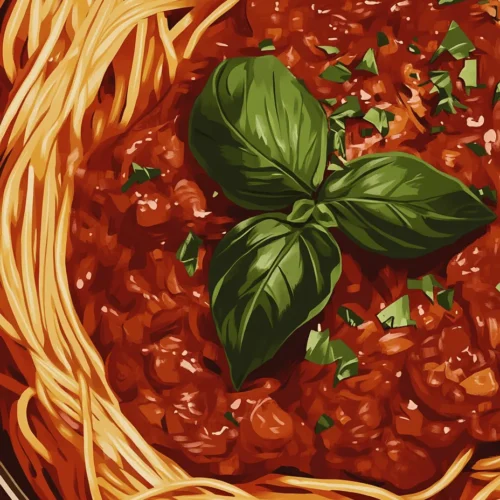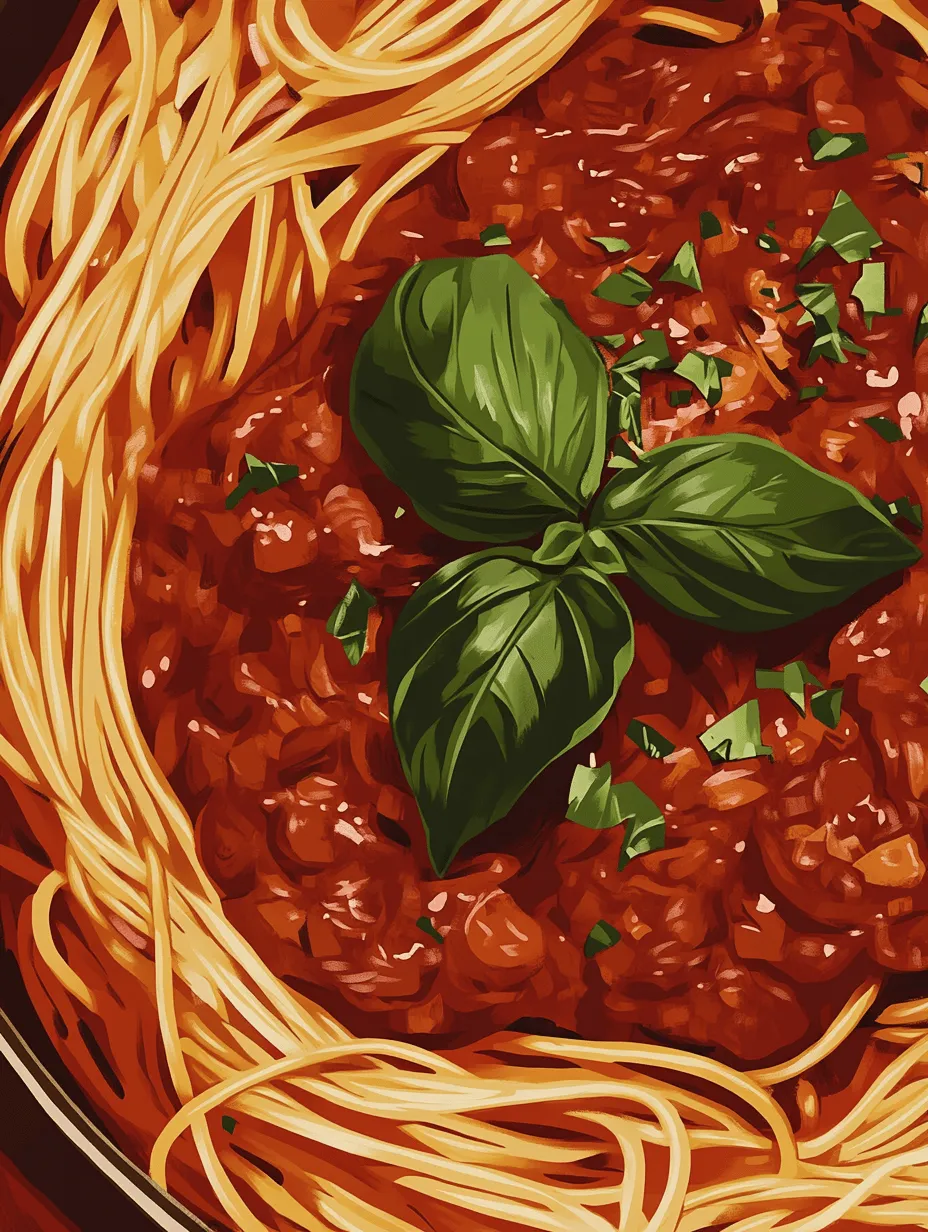Introduction
Homemade sauces are the heart and soul of Italian cuisine, often celebrated for their rich flavors and comforting qualities. They bring warmth to family gatherings, serve as the foundation for beloved dishes, and elevate simple meals into culinary masterpieces. The beauty of crafting your own spaghetti sauce lies not only in the delightful tastes but also in the experience of cooking with fresh, quality ingredients that you can personalize to suit your palate.
Creating a homemade spaghetti sauce is akin to painting your own culinary masterpiece. It allows you to experiment with flavors, textures, and aromas, transforming basic ingredients into a sauce that reflects your unique style. This recipe offers a delightful balance of sweetness, acidity, and depth, ensuring that each bite is a celebration of Italian heritage. With a few fresh ingredients and straightforward techniques, you can craft a sauce that’s not only delicious but also made with love.
In this article, we will delve into the essential ingredients that form the backbone of this sauce, guiding you through the steps to create your very own homemade spaghetti sauce that will become a staple in your kitchen. Let’s embark on this culinary adventure together!
Understanding the Ingredients
To make an exceptional spaghetti sauce, understanding each ingredient’s role is crucial. Here’s a breakdown of the essential components that will elevate your sauce from ordinary to extraordinary.
Olive Oil
The foundation of any good Italian sauce begins with olive oil. Known for its health benefits, including heart-healthy fats and antioxidants, olive oil also contributes a rich, fruity flavor that enhances the overall taste of the sauce. When selecting olive oil, opt for extra virgin, as it is the highest quality and has the most robust flavor profile, perfect for sautéing and drizzling over your finished dish.
Onions
Onions are integral to building the flavor base of your sauce. They provide sweetness and complexity, which deepens as you cook them. Sautéing onions until they become translucent is key to unleashing their natural sugars, creating a fragrant aroma that sets the stage for the rest of the ingredients. A finely chopped onion will blend seamlessly into your sauce, ensuring even flavor distribution.
Garlic
Garlic is another essential ingredient that adds depth and warmth to your sauce. The use of fresh garlic is paramount; it’s more aromatic and flavorful than its powdered counterpart. When minced and sautéed with onions, garlic releases its essential oils, creating a savory foundation that enhances the sauce’s overall profile. Be cautious with cooking time, as burnt garlic can impart a bitter taste.
Crushed Tomatoes
The star of the spaghetti sauce is undoubtedly the tomatoes. Choosing the right tomatoes is vital for achieving the best flavor and consistency. Crushed tomatoes are ideal, as they provide a thick base without being overly chunky. Look for canned tomatoes that are labeled as San Marzano, known for their sweetness and low acidity, or opt for fresh ripe tomatoes in season for a more vibrant taste. The quality of your tomatoes will significantly affect the final flavor of your sauce.
Tomato Paste
While crushed tomatoes provide bulk and body, tomato paste is the secret weapon for enhancing the richness and depth of your spaghetti sauce. It’s concentrated and adds a velvety texture, making the sauce feel luxurious. A small amount of tomato paste can dramatically elevate the flavor, so don’t skip this ingredient. Cook it briefly with the onions and garlic to develop its sweetness before adding the crushed tomatoes.
Dried Herbs (Basil and Oregano)
Herbs are essential in Italian cooking, and dried basil and oregano are classic choices for spaghetti sauce. These herbs bring an aromatic quality that complements the tomatoes beautifully. Dried herbs are more concentrated than fresh, so a little goes a long way. They should be added early in the cooking process to allow their flavors to infuse into the sauce. For an extra layer of flavor, consider adding fresh herbs towards the end of cooking for a bright, fresh finish.
Sugar
You might wonder why sugar is included in a savory recipe like spaghetti sauce. The answer lies in balancing the acidity of the tomatoes. Sometimes, canned tomatoes can have a sharp, acidic taste that can overpower the sauce. A pinch of sugar helps to counteract this acidity, resulting in a well-rounded flavor. Use it judiciously—just enough to take the edge off without making the sauce sweet.
Salt and Pepper
Seasoning is crucial in any dish, and spaghetti sauce is no exception. Salt enhances the flavors of all the ingredients, while freshly cracked black pepper adds a touch of warmth and complexity. Season the sauce gradually, tasting as you go to achieve a perfect balance. Remember, you can always add more seasoning, but you can’t take it away once it’s in the pot.
Fresh Basil as a Garnish
Once your sauce is ready, a sprinkle of fresh basil adds a vibrant touch. Not only does it provide a pop of color, but it also imparts a fresh, aromatic flavor that brightens the entire dish. Use whole leaves or chiffonade for a beautiful presentation, and consider adding basil just before serving to retain its fresh taste and fragrance.
Step-by-Step Guide to Making Homemade Spaghetti Sauce
Now that we understand the significance of each ingredient, it’s time to dive into the step-by-step process of making your homemade spaghetti sauce. With a clear focus on technique and timing, you’ll be able to create a sauce that’s bursting with flavor.
Step 1: Sautéing Aromatics
Begin by heating a generous amount of olive oil in a large, heavy-bottomed pot over medium heat. The oil should shimmer but not smoke. Add the finely chopped onions and a pinch of salt. This initial salt helps to draw out moisture from the onions, leading to a sweeter flavor and more even cooking. Sauté the onions for about 5-7 minutes, stirring occasionally, until they become soft and translucent.
Step 2: Adding Garlic
Once the onions are ready, it’s time to add the minced garlic. Garlic cooks quickly, so be attentive—sauté it for about 1-2 minutes until fragrant but not browned. This is crucial, as burnt garlic can impart a bitter flavor to your sauce. Stir continuously, allowing the garlic to meld with the onions, creating a fragrant base for your sauce.
Step 3: Incorporating the Tomatoes
Next, it’s time to add your crushed tomatoes and tomato paste. Stir the mixture well, ensuring that the tomato paste is fully incorporated into the sautéed aromatics. The combination of crushed tomatoes and tomato paste will create a rich, flavorful sauce. Allow this mixture to cook for a few minutes, letting the flavors meld together.
Step 4: Seasoning the Sauce
Now comes the critical step of seasoning. Sprinkle in your dried basil and oregano, along with a touch of sugar, salt, and freshly cracked black pepper. Stir well to combine, and taste the sauce. Adjust the seasoning as needed, remembering that a well-seasoned sauce is key to a delicious final dish.
Step 5: Simmering the Sauce
After seasoning, reduce the heat to low and allow your sauce to simmer gently. This slow cooking process is vital for developing deep, layered flavors. Let the sauce simmer for at least 30 minutes, but feel free to extend this time for a more robust taste. Stir occasionally and check the consistency; if the sauce is too thick, you can add a splash of water or broth to achieve your desired texture.
By following these steps, you’ll be well on your way to creating a homemade spaghetti sauce that’s not only delicious but also filled with the love and care of a home-cooked meal. The next part of this article will delve deeper into additional tips for perfecting your sauce and addressing some common questions that may arise during your cooking journey. Stay tuned for more culinary insights!

Discussion on the Benefits of Simmering and Time
Simmering is a crucial step in the process of making homemade spaghetti sauce. This gentle cooking method allows the flavors to meld and deepen, creating a rich and complex sauce that can’t be replicated in store-bought versions. When the sauce simmers, the acidity of the tomatoes softens, and the sweetness of the vegetables intensifies, resulting in a well-rounded flavor profile.
The time you invest in simmering your sauce can greatly influence the final outcome. A minimum of 30 minutes is recommended, but for optimal results, consider letting it simmer for an hour or even longer. This extended simmering time not only enhances the taste but also allows for the evaporation of excess water, thickening the sauce to the perfect consistency. Remember to stir occasionally to prevent any sticking at the bottom of the pot. A slow simmer also provides an opportunity to add in fresh herbs toward the end, which will retain their aromatic qualities and freshness.
Final Touches: Tasting and Adjusting for Personal Preference
As your sauce simmers, tasting is an essential part of the process. Once you reach the final stages of cooking, take a moment to sample the sauce. This is your opportunity to adjust the flavors to your liking. You may want to add a pinch of salt, a dash of pepper, or a sprinkle of sugar to balance the acidity. Some might prefer a little heat; if so, a pinch of red pepper flakes can elevate the flavor profile beautifully.
For those who enjoy a touch of sweetness, consider adding a teaspoon of honey or a splash of balsamic vinegar to enhance the sauce’s depth. Ultimately, the goal is to create a sauce that resonates with your palate, so don’t hesitate to experiment with seasonings until it feels just right.
Pairing Suggestions for Spaghetti Sauce
Recommended Pasta Types That Complement the Sauce
While traditional spaghetti is a classic choice, the versatility of your homemade sauce allows for a variety of pasta types. Long noodles like fettuccine or linguine can provide a delightful twist, while shorter pasta shapes like penne or rigatoni are excellent for capturing the sauce in their ridges.
For a gluten-free option, consider using brown rice pasta or chickpea pasta, which will still deliver a hearty and satisfying meal. The shape and texture of the pasta you choose can elevate your dish, so feel free to experiment and find your favorite pairing.
Exploring Different Protein Options
To make your spaghetti sauce a complete meal, consider adding proteins. Traditional meatballs are always a favorite, but you can also experiment with grilled chicken breast, sautéed shrimp, or even Italian sausage for a heartier flavor. For a vegetarian option, try adding lentil balls or roasted chickpeas, which can provide a satisfying bite and pair wonderfully with the sauce.
Suggestions for Side Dishes That Enhance the Meal Experience
Complement your spaghetti sauce with side dishes that enhance the overall meal experience. A classic Caesar salad or a fresh arugula salad with a lemon vinaigrette can add a refreshing contrast to the richness of the sauce. Garlic bread or a warm baguette is also a perfect accompaniment, allowing you to savor every last drop of the delicious sauce.
For a heartier side, consider serving roasted vegetables or a ratatouille, which can incorporate seasonal produce and add nutritional value to your meal.
Wine Pairings That Go Well with Spaghetti and Sauce
When it comes to wine pairings, red wines typically work best with spaghetti and tomato-based sauces. A medium-bodied Chianti or a zesty Sangiovese can beautifully complement the acidity of the tomatoes. If you prefer white wine, a crisp Pinot Grigio or a full-bodied Chardonnay can provide a delightful contrast.
Consider serving the same wine that you used in the sauce for an added layer of flavor, making the dining experience even more cohesive.
The Nutritional Value of Homemade Spaghetti Sauce
Breakdown of the Nutritional Content of the Main Ingredients
Homemade spaghetti sauce can be a nutritious addition to your meals. The primary ingredients—tomatoes, garlic, onions, and herbs—are packed with vitamins, minerals, and antioxidants. Tomatoes are rich in vitamin C, potassium, and lycopene, a powerful antioxidant linked to various health benefits, including heart health and reduced cancer risk.
Garlic and onions contribute their own health benefits, including anti-inflammatory properties and potential immune-boosting effects. By using fresh herbs like basil and oregano, you not only enhance flavor but also add additional nutrients, making your sauce a wholesome choice.
Health Benefits of Using Fresh Ingredients Versus Store-Bought Sauces
One of the significant advantages of making homemade spaghetti sauce is the ability to control the ingredients. Store-bought sauces often contain added sugars, preservatives, and unhealthy fats, which can detract from the nutritional value. By using fresh ingredients, you can create a sauce that is not only delicious but also healthier.
Tips for Making the Sauce Healthier
To make your spaghetti sauce even healthier, consider these tips:
– Reduce Sugar: Many store-bought sauces contain excessive sugar to balance acidity. Instead, use naturally sweet ingredients like carrots or sweet bell peppers to enhance flavor without added sugar.
– Add Vegetables: Boost the nutritional content by incorporating additional vegetables such as zucchini, spinach, or mushrooms. These not only add flavor and texture but also increase the fiber content of your sauce.
– Use Whole Grain Pasta: Opt for whole-grain or legume-based pasta to increase the fiber and protein content of your meal.
Cultural Significance of Spaghetti Sauce
The Role of Spaghetti and Sauce in Italian Culture and Cuisine
Spaghetti and sauce hold a cherished place in Italian culture, representing comfort, tradition, and family gatherings. The dish is often enjoyed during celebrations and family meals, symbolizing togetherness and the joy of sharing food.
In Italy, each region has its variations of spaghetti sauce, influenced by local ingredients and culinary customs. From the rich ragù of Bologna to the fresh marinara of Naples, spaghetti sauce reflects the diverse culinary landscape of Italy.
How Homemade Sauces Have Become a Staple in Family Traditions
The tradition of making homemade spaghetti sauce has been passed down through generations, with each family adding their unique touch to the recipe. Making sauce from scratch can be a communal activity, where family members gather to chop vegetables, simmer sauces, and share stories, creating lasting memories in the kitchen.
The Evolution of Spaghetti Sauce Recipes Over Time
As culinary traditions evolve, so do spaghetti sauce recipes. Modern interpretations often incorporate new ingredients and techniques, reflecting contemporary tastes while honoring classic methods. The rise of vegetarian and vegan diets has also led to more innovative sauce recipes that cater to diverse dietary preferences.
Creative Variations of Spaghetti Sauce
Exploring Different Regional Styles of Spaghetti Sauce
The beauty of spaghetti sauce lies in its versatility, allowing for countless regional variations. For instance, marinara sauce, a quick and simple tomato sauce, is perfect for those who want a light, fresh flavor. In contrast, a puttanesca sauce, featuring olives and capers, offers a bold and savory profile.
Each regional style brings its own flair, inviting you to explore and recreate different flavors in your kitchen.
Adding Vegetables for a More Robust Sauce
For a heartier sauce, consider adding vegetables such as bell peppers, carrots, or mushrooms. Sautéing these vegetables before adding the tomatoes can create a deeper flavor, resulting in a rich and satisfying sauce.
Incorporating Proteins into the Sauce
For those looking for a one-pot meal, incorporating proteins directly into the sauce can be a game-changer. Ground meat, sausage, or even diced chicken can be browned and simmered with the sauce for a rich and savory dish.
Making the Sauce Vegan-Friendly: Tips for Substitutions
To create a vegan-friendly spaghetti sauce, simply omit any meat and consider adding protein-rich ingredients like lentils or chickpeas. Nutritional yeast can provide a cheesy flavor without the dairy, while a splash of balsamic vinegar can add depth.
Conclusion
Making homemade spaghetti sauce is not just about creating a delicious meal; it’s about embracing the joy of cooking and the satisfaction that comes from crafting something from scratch. The rich flavors of your sauce, combined with the perfect pasta and accompanying dishes, can transform a simple dinner into a memorable culinary experience.
As you experiment with the recipe, let your creativity shine. Whether you stick to the classic version or explore variations inspired by regional styles, the possibilities are endless. Homemade cooking fosters connection, bringing family and friends together around the table, creating lasting memories and traditions.
Embrace this art of sauce-making, and relish the impact it can have on your family gatherings and everyday meals. Your kitchen is a canvas—make it your own.


